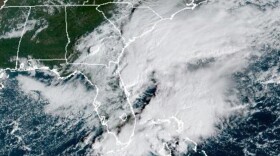North Carolina is home to 35 dams that are both in "unsatisfactory" condition and also in a "high hazard" classification.
This means these dams have deficiencies "that may require immediate or emergency remedial action" and are big enough that a failure "will likely cause loss of life or serious damage to homes, industrial and commercial buildings, important public utilities, primary highways, or major railroads," according to definitions provided by the Division of Energy, Mineral and Land Resources, part of the N.C. Department of Environmental Quality, and which regulates dams in the state.
In addition, North Carolina has another 159 dams classified as "high hazard" that are in "poor" condition, meaning, "dam safety deficiency is recognized for loading conditions which may realistically occur. Remedial action is necessary," according to state data.
There are more than 6,000 dams across North Carolina, many of which are very small. Nearly 4,000 dams are classified as "low" hazard, meaning in the event of a failure, there would be a disruption of less than 25 vehicles per day, or an economic damage of less than $30,000.

The 194 dams in poor or unsatisfactory condition that are also a high-safety hazard represent 3% of all dams in North Carolina. However, that figure is up from 168 high-hazard dams in poor or unsatisfactory condition in an Associated Press analysis done in 2019.
The AP recently updated its analysis and tallied more than 2,200 high-hazard dams in poor or unsatisfactory condition across the United States, up substantially from the analysis from three years ago. The actual number is likely higher, although it's unclear because a couple of states don't track such data and many federal agencies refuse to release details about their dams' conditions or the dangers they pose.
There are a variety of reasons for the rising number of troubled dams: a heightened emphasis by some state regulators has turned up new concerns. Deferred maintenance has resulted in worsened conditions. Dams that were built decades ago now often pose more of a hazard than originally envisioned because homes, businesses, and highways have cropped up below them.
A changing climate also plays a role. A warming atmosphere can bring stronger storms with heavier rainfalls that can overwhelm older dams lacking adequately-sized spillway outlets.
The $1 trillion infrastructure bill signed last year by President Joe Biden will provide about $3 billion for dam-related projects, but that’s just a fraction of what’s needed for safety upgrades and repairs to the thousands of dams across the country.
In North Carolina, three dams in poor condition could soon see their rating improved. Those three are owned by Duke Energy and located at the HF Lee plant inactive ash basins. A Duke Energy spokesman said the company has made improvements; a DEQ spokesman confirmed the upgrades and that a final inspection report – possibly upgrading the safety rating of the dams – would be available next month.
The 35 high hazard dams in unsatisfactory condition include:
Dam Name (County)
- Anson County WWTP Upper Dam (Sludge Lagoon) (Anson)
- Anson County WWTP Lower Dam (Sludge Lagoon) (Anson)
- Henry River Dam (Burke)
- Tanglewood Forest Dam Lower (Cherokee)
- Barbour Pond Dam (Cumberland)
- Rhodes Lake Dam (Cumberland)
- Pritchard Dam (Cumberland)
- Strickland Bridge Dam (Cumberland)
- Glossons Lake Dam #2 (Davidson)
- Freeman Lake Dam (Davidson)
- Jerry Clinard Lake Dam (Davidson)
- Sabrina Lake Dam (Forsyth)
- Blanchard Dam #4 (Harnett)
- Sherman Lakes Lower (Harnett)
- Sherman Lakes Upper (Harnett)
- Sunset Lake Dam (Hoke)
- Rick Howell Lake Dam (Iredell)
- Tull Millpond Dam (Lenoir)
- Burningtown Lake Dam (Macon)
- Wildwood Mountain Dam (Macon)
- Pamlico Regional Wastewater Dike (Pamlico)
- Lake Glenwood Dam (Pitt)
- Richardson Lake Dam (Randolph)
- Young Lake Dam (Rockingham)
- Ed Wilkins Dam (Rockingham)
- Chicken Springs Dam (Rowan)
- Deese Road Dam (Stanly)
- Sagar Dam Lower Dam (Transylvania)
- Line Runner Ridge Dam (Transylvania)
- Indian Lake Lower Dam (Transylvania)
- Pisgah Forest Farm Dam (Transylvania)
- Forest Lake Dam (Transylvania)
- Underwood Dam (Wake)
- Cogdell Pond Dam (Wayne)
- Old Crescent Lake Dam (Wayne)
The Associated Press contributed to this report.







